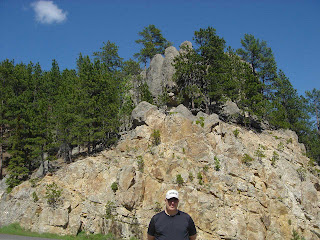
Sunday, June 28, 2009
Cody

Saturday, June 27, 2009
Thermopolis
Thursday, June 25, 2009
The Crazy Horse Memorial
Just 8 miles from Mt. Rushmore, another monumental sculpture, The Crazy Horse Memorial, is taking shape. Designed and started in 1948 by sculptor Korczak Ziółkowski, the statue of Crazy Horse, an Oglala Lakota warrior riding a horse, will be the largest in the world when (or if) it is finished.

Wednesday, June 24, 2009
Mt. Rushmore National Memorial
Tuesday, June 23, 2009
Custer State Park
Located in the Black Hills, Custer State Park is South Dakota’s largest and first state park. The Black Hills are an isolated area of mountains, not part of the main body of the Rocky Mountains. It is a very pretty area of small mountains and trees, surrounded by the plains.
The Black Hills really are black.

Monday, June 22, 2009
Custer, South Dakota
Sunday, June 21, 2009
KILI Radio 90.1 FM

Wounded Knee, South Dakota

The Wounded Knee Massacre was not one of the great moments in U.S. history. On December 29, 1890 500 U.S. Army cavalry troops had surrounded an encampment of Lakota (Sioux) Indians. They were the last Indians still at war with the U.S., but had finally agreed to stop fighting. During their disarmament, confusion with a deaf tribesman lead to chaos and mayhem.
When it was all over, about 300 men, women, and children of the Lakota had been killed. 25 US troops were dead, some probably killed by “friendly fire.” 150 Indians were thought to have fled, but many of them later died of hypothermia.
Inexplicably, the United States Army awarded the massacre’s participants the most “Medals of Honor” that have ever been awarded in a single engagement.

The bodies were unceremoniously dumped in a mass grave. Not until 1903 was a monument placed on the site by surviving relatives. The site, located in the “Pine Ridge Indian Reservation” (not a name used much by its residents) in southern South Dakota, has been declared a National Historic Landmark.
Though it is the eighth-largest reservation in the United States, larger than Delaware and Rhode Island combined, most of the land comprising the reservation lies within Shannon County and Jackson County, two of the poorest counties in the United States.
Saturday, June 20, 2009
Thursday, June 18, 2009
A visitor from Atlanta!
While we were in Madison, Glenn got an email from Colin, one of his former employees in Atlanta, that he would be in Sioux Falls for business., So we drove the 50 miles down to the Sioux Falls airport to meet him up with him.
Jill got this great picture of the plane he flew in on (a 50-seat Bombardier Canadair CRJ-200ER), but we were so busy eating and talking that we forgot to get a picture of the three of us at dinner.

So instead, here’s a picture of Colin. It was taken during the 2003 IBC in Amsterdam. He’s sitting outside the Leidseplein Theater, home of Boom Chicago.
As falls Sue, so falls Sioux Falls

The falls were a source of power and the area was more industrial than scenic. By the 1970s the area was pretty run down and in need of more than just a face lift. It was redeveloped into Falls Park.

EROS
EROS is the Center for Earth Resources Observation and Science. Located 14 miles northeast of Sioux Falls, South Dakota, it is the nation’s archive of all “remotely sensed” imagery of the earth’s surface including civilian satellite, aircraft and now even declassified military imagery.

At EROS, photography was allowed inside but not outside.
Wednesday, June 17, 2009
The Madison Public Library
Lake Herman State Park

These "prairie skyscrapers" are located just west of town between the town and the park. They are fairly new and they are very big.










































